Satellite Time-Series Analysis for Thermal Anomaly Detection in the Naples Urban Area, Italy
Abstract
:1. Introduction
1.1. Aim of the Work
1.2. Study Area
2. Materials and Methods
2.1. Data
2.1.1. Satellite Data LST
2.1.2. Emissivity
2.1.3. Atmospheric Correction Coefficients (A, B, and C)
2.2. Processing
2.3. Results Characterization by Using the Land Cover
3. Results and Discussion
Spatial Analysis
4. Conclusions
Author Contributions
Funding
Institutional Review Board Statement
Informed Consent Statement
Data Availability Statement
Conflicts of Interest
Abbreviations
| ASTER | Advanced Spaceborne Thermal Emission and Reflection Radiometer |
| ASTER-GED | ASTER Global Emissivity Database |
| CLC | Corine LC |
| CS | Coldspot |
| EAV | Ente Autonomo Volturno |
| EO | Earth Observation |
| FVC | Fractional Vegetation Cover |
| GEE | Google Earth Engine |
| GSD | Ground Sample Distance |
| HS | Hotspot |
| IR | Infrared |
| LC | Land Cover |
| LST | Land Surface Temperature |
| NCAR | National Center for Atmospheric Research |
| NCEP | National Center for Environmental Prediction |
| NDBI | Normalized Difference Buildings Index |
| NDVI | Normalized Difference Vegetation Index |
| NIR | Near Infrared |
| OLI | Operation Land Imager |
| SMW | Statistical Mono Window |
| Tb | Brightness Temperature |
| TCWV | Total Column Water Vapour |
| TIR | Thermal Infrared |
| TIRS | TIR Sensor |
| TM | Thematic Mapper |
| TOA | Top of Atmosphere |
| TPW | Total Predictable Water |
| USGS | United States Geological Survey |
| VCM | Vegetation Cover Method |
| VIS | Visible |
References
- Available online: https://www.ipcc.ch/report/ar6/syr/downloads/report/IPCC_AR6_SYR_LongerReport.pdf (accessed on 15 March 2024).
- Masson-Delmotte, V.P.; Zhai, H.-O.; Pörtner, D.; Roberts, J.; Skea, P.R.; Shukla, A.; Pirani, W.; Moufouma-Okia, C.; Péan, R.; Pidcock, S.; et al. (Eds.) Global Warming of 1.5 °C. An IPCC Special Report on the Impacts of Global Warming of 1.5 °C above Pre-Industrial Levels and Related Global Greenhouse Gas Emission Pathways, in the Context of Strengthening the Global Response to the Threat of Climate Change, Sustainable Development, and Efforts to Eradicate Poverty; IPCC: Geneva, Switzerland, 2018. [Google Scholar]
- Jenkins, S.; Povey, A.; Gettelman, A.; Grainger, A.; Stier, P.; Allen, M. Is Anthropogenic Global Warming Accelerating? J. Clim. 2022, 35, 7873–7890. [Google Scholar] [CrossRef]
- IPCC. Sections. In Climate Change 2023: Synthesis Report. Contribution of Working Groups I, II, and III to the Sixth Assessment Report of the Intergovernmental Panel on Climate Change; Core Writing Team, Lee, H., Romero, J., Eds.; IPCC: Geneva, Switzerland, 2023. [Google Scholar]
- Pachauri, R.k.; Meyer, L. Synthesis Report; IPCC: Geneva, Switzerland, 2014. [Google Scholar]
- IPCC. 2007: Climate Change 2007: Synthesis Report. Contribution of Working Groups I, II and III to the Fourth Assessment Report of the Intergovernmental Panel on Climate Change; Core Writing Team, Pachauri, R.K., Reisinger, A., Eds.; IPCC: Geneva, Switzerland; 104p.
- Zhou, D.; Xiao, J.; Bonafoni, S.; Berger, C.; Deilami, K.; Zhou, Y.; Frolking, S.; Yao, R.; Qiao, Z.; Sobrino, J.A. Satellite Remote Sensing of Surface Urban Heat Island: Progress, Challenges, and Perspectives. Remote Sens. 2018, 11, 48. [Google Scholar] [CrossRef]
- Available online: https://www.regione.campania.it/regione/it/news/comunicati-2023/17-07-2023-comunicato-stampa-n-181-ondata-di-calore-in-campania-temperature-anche-al-di-sopra-dei-40-gradi?page=1#:~:text=Comunicato%20stampa%20n.-,181%20%2D%20Ondata%20di%20calore%20in%20Campania%3A%20temperature%20anche%20al,di%20sopra%20dei%2040%20gradi&text=La%20Protezione%20Civile%20della%20Campania,dal%20Centro%20Funzionale%20della%20Regione (accessed on 17 March 2024).
- Available online: https://wmo.int/topics/heatwave (accessed on 17 March 2024).
- Available online: http://www.nimbus.it/eventi/2023/230721CaldoEstremoItalia.htm (accessed on 17 March 2024).
- Available online: https://www.ansa.it/english/news/general_news/2023/07/18/italys-extraordinary-heatwave-approaches-peak_3e7befc4-eaab-4eb9-ae12-14eef73d0d83.html (accessed on 17 March 2024).
- Available online: https://meteologix.com/it/reanalysis/ecmwf-era5/foggia/temperature/20230717-1200z.html (accessed on 17 March 2024).
- Ouyang, Z.; Sciusco, P.; Jiao, T.; Feron, S.; Lei, C.; Li, F.; John, R.; Fan, P.; Li, X.; Williams, C.A.; et al. Albedo changes caused by future urbanization contribute to global warming. Nat. Commun. 2022, 13, 3800. [Google Scholar] [CrossRef] [PubMed]
- Available online: https://wmo.int/content/climate-change-and-heatwaves (accessed on 17 March 2024).
- Available online: https://www.cmcc.it/it/report-napoli (accessed on 17 March 2024).
- Parison, S.; Chaumont, M.; Kounkou-Arnaud, R.; Long, F.; Bernik, A.; Da Silva, M.; Hendel, M. The effects of greening a parking lot as a heat mitigation strategy on outdoor thermal stress using fixed and mobile measurements: Case-study project “tertiary forest”. Sustain. Cities Soc. 2023, 98, 104818. [Google Scholar] [CrossRef]
- Farhadi, H.; Faizi, M.; Sanaieian, H. Mitigating the urban heat island in a residential area in Tehran: Investigating the role of vegetation, materials, and orientation of buildings. Sustain. Cities Soc. 2019, 46, 101448. [Google Scholar] [CrossRef]
- Kousis, I.; Pisello, A.L. Evaluating the performance of cool pavements for urban heat island mitigation under realistic conditions: A systematic review and meta-analysis. Urban Clim. 2023, 49, 101470. [Google Scholar] [CrossRef]
- Gartland, L. Heat Island, Understanding and Mitigating Heat in Urban Areas; Routledge: London, UK, 2008. [Google Scholar]
- Irfeey, A.; Chau, H.; Sumaiya, M.; Wai, C.; Muttil, N.; Jamei, E. Sustainable Mitigation Strategies for Urban Heat Island Effects in Urban Areas. Sustainability 2023, 15, 10767. [Google Scholar] [CrossRef]
- Gagliano, A.; Detommaso, M.; Nocera, F.; Evola, G. A multi-criteria methodology for comparing the energy and environmental behavior of cool, green and traditional roofs. Build. Environ. 2015, 90, 71–81. [Google Scholar] [CrossRef]
- Ermida, S.L.; Soares, P.; Mantas, V.; Gottsche, F.; Trigo, I. Google Earth Engine Open-Source Code for Land Surface Temperature Estimation from the Landsat Series. Remote Sens. 2020, 12, 1471. [Google Scholar] [CrossRef]
- Aletba, S.R.O.; Hassan, N.A.; Jaya, R.P.; Aminudin, E.; Mahmud, M.Z.H.; Mohamed, A.; Hussein, A.A. Thermal performance of cooling strategies for asphalt pavement: A state-of-art review. J. Traffic Transp. Eng. 2021, 8, 356–373. [Google Scholar] [CrossRef]
- Available online: https://land.copernicus.eu/en/products/corine-land-cover (accessed on 17 March 2024).
- Cangialosi, D.; Tronu, D.; Vacca, D. Istat, Profili Delle Città Metropolitane. 2023.Istat. 2024. Available online: https://www.istat.it/it/files/2023/02/Statistica-Focus-Citt%C3%A0-Metropolitane.pdf (accessed on 15 March 2024).
- Silvestri, M.; Diaz, J.A.; Marotta, E.; Dalla Via, G.; Bellucci Sessa, E.; Caputo, T.; Buongiorno, M.F.; Sansivero, F.; Musacchio, M.; Belviso, P. The 2016 Field Campaign of la Solfatara Volcano: Monitoring Methods and Instruments for Volcanic Surveillance; Technical Report; INGV: Roma, Italy, 2017. [Google Scholar]
- Ascione, A.; Aucelli, P.; CInque, A.; Di Paola, G.; Mattei, G.; Ruello, M.; Ermolli, E.; Santangelo, M.; Valente, E. Geomorphology of Naples and the Campi Flegrei: Human and natural landscapes in a restless land. J. Maps 2021, 17, 18–28. [Google Scholar] [CrossRef]
- Orsi, G.; De Vita, S.; Di Vito, M. The restless resurgent Campi Flegrei nested caldera (Italy): Constraints in its evolution and configuration. J. Volcanol. Geotherm. Res. 1996, 74, 179–214. [Google Scholar] [CrossRef]
- Guha, S.; Govil, H.; Dey, A.; Gill, N. Analytical study of Land Surface temperature with NDVI and NDBI using Landsat 8 OLI and TIRS data in Florence and Naples city, Italy. Eur. J. Remote Sens. 2018, 51, 667–678. [Google Scholar] [CrossRef]
- Available online: https://www.naples.climatemps.com/ (accessed on 17 March 2024).
- Yang, J.; Xin, J.; Zhang, Y.; Xiao, X.; Xia, J.C. Contributions of sea-land breeze and local climate zones to daytime and nighttime heat island intensity. NPJ Urban Sustain. 2022, 2, 12. [Google Scholar] [CrossRef]
- Roy, D.P.; Wulder, M.A.; Loveland, T.R.; Woodcock, C.E.; Allen, R.G.; Anderson, M.C.; Helder, D.; Irons, J.R.; Johnson, D.M.; Kennedy, R.; et al. Landsat-8: Science and product vision for terrestrial global change research. Remote Sens. Environ. 2014, 145, 154–172. [Google Scholar] [CrossRef]
- Landsat 8. Available online: https://landsat.gsfc.nasa.gov/landsat-8/ (accessed on 30 November 2023).
- USGS. Landsat 8 OLI and TIRS Calibration Notices. Available online: https://www.usgs.gov/land-resources/nli/landsat/landsat-8-oli-and-tirs-calibration-notices (accessed on 30 November 2023).
- Li, Z.L.; Wu, H.; Wang, N.; Qiu, S.; Sobrino, J.A.; Wan, Z.; Tang, B.H.; Yan, G. LSE retrieval from satellite data. Int. J. Remote Sens. 2013, 34, 3084–3127. [Google Scholar] [CrossRef]
- Subed, I.; Silverman, T.J.; Deceglie, M.G.; Podraza, N.J. Emissivity of solar cell cover glass calculated from infrared reflectance measurements. Sol. Energy Mater. Sol. Cells 2019, 190, 98–102. [Google Scholar] [CrossRef]
- Hulley, G.; Hook, S. The Aster Global emissivity database. Geophys. Res. Lett. 2015, 42, 7966–7976. [Google Scholar] [CrossRef]
- ASTER Global Emissivity Dataset GED. Available online: https://lpdaac.usgs.gov/products/ag100v003/ (accessed on 30 November 2023).
- Barbieri, T.; Despini, F.; Teggi, S. A multitemporal analysis of Land Surface Temperature using Landsat 8 data over Modena. Sustainability 2018, 10, 1678. [Google Scholar] [CrossRef]
- Available online: https://www.agricolus.com/indici-vegetazione-ndvi-ndmi-istruzioni-luso/ (accessed on 17 March 2024).
- Ermida, S.; Hulley, G.; Gottsche, F.; Trigo, I. Combined vegetation cover and Temperature Emissivity Separation (V-TES) method to estimate Land Surface Emissivity. IEEE Trans. Geosci. Remote Sens. 2023, 61, 4407318. [Google Scholar] [CrossRef]
- Wang, F.; Qin, Z.; Song, C.; Tu, L.; Karnieli, A.; Zhao, S. An improved Mono-Window Algorithm for Land Surface Temperature retrieval from Landsat 8 Thermal InfraRed Sensor Data. Remote Sens. 2015, 7, 4268–4289. [Google Scholar] [CrossRef]
- Munoz, J.C.; Sobrino, J.; Plaza, A.; Guanter, L.; Moreno, J.; Martinez, P. Comparison between FVC retrievals from Vegetation indices. Sensors 2009, 9, 768–793. [Google Scholar]
- Rabuffi, F.; Silvestri, M.; Musacchio, M.; Romaniello, V.; Buongiorno, M.F. A statistical approach to Satellite Time Series Analysis to Detect Changes in Thermal Activities: The Volcano Island 2021 Crisis. Remote Sens. 2022, 14, 3933. [Google Scholar] [CrossRef]
- Orusa, T.; Viani, A.; Moyo, B.; Cammaneri, D.; Borgogno-Mondino, E. Risk Assessment of Rising Temperatures Using Landsat 4-9 LST Time Series and Meta Population Dataset: An Application in Valle D’Aosta Valley, NW Italy. Remote Sens. 2023, 15, 2348. [Google Scholar] [CrossRef]
- Buttner, G.; Kosztra, B.; Maucha, G.; Pataki, R.; Kleeschulte, S.; Schroder, C.; Littkopf, A. Corine Land Monitoring Service: Corine Land Cover. 2021. Available online: https://land.copernicus.eu/en/technical-library/clc-product-user-manual/@@download/file (accessed on 15 March 2024).
- Mingarro, M.; Lobo, J.M. European national parks protect their surroundings but not everywhere: A study using Land Use/Land Cover cover dynamics derived from Corine Land Cover data. Land Use Policy 2023, 124, 106434. [Google Scholar] [CrossRef]
- Uemoto, K.L.; Sato, N.M.N.; John, V.M. Estimating the thermal performance of cool colored paints. Energy Build. 2010, 42, 17–22. [Google Scholar] [CrossRef]
- Mandal, J.; Yang, Y.; Yu, N.; Raman, A.P. Paints as a Scalable and Effective Radiative Cooling Technology for Buildings. Joule 2020, 4, 1350–1356. [Google Scholar] [CrossRef]
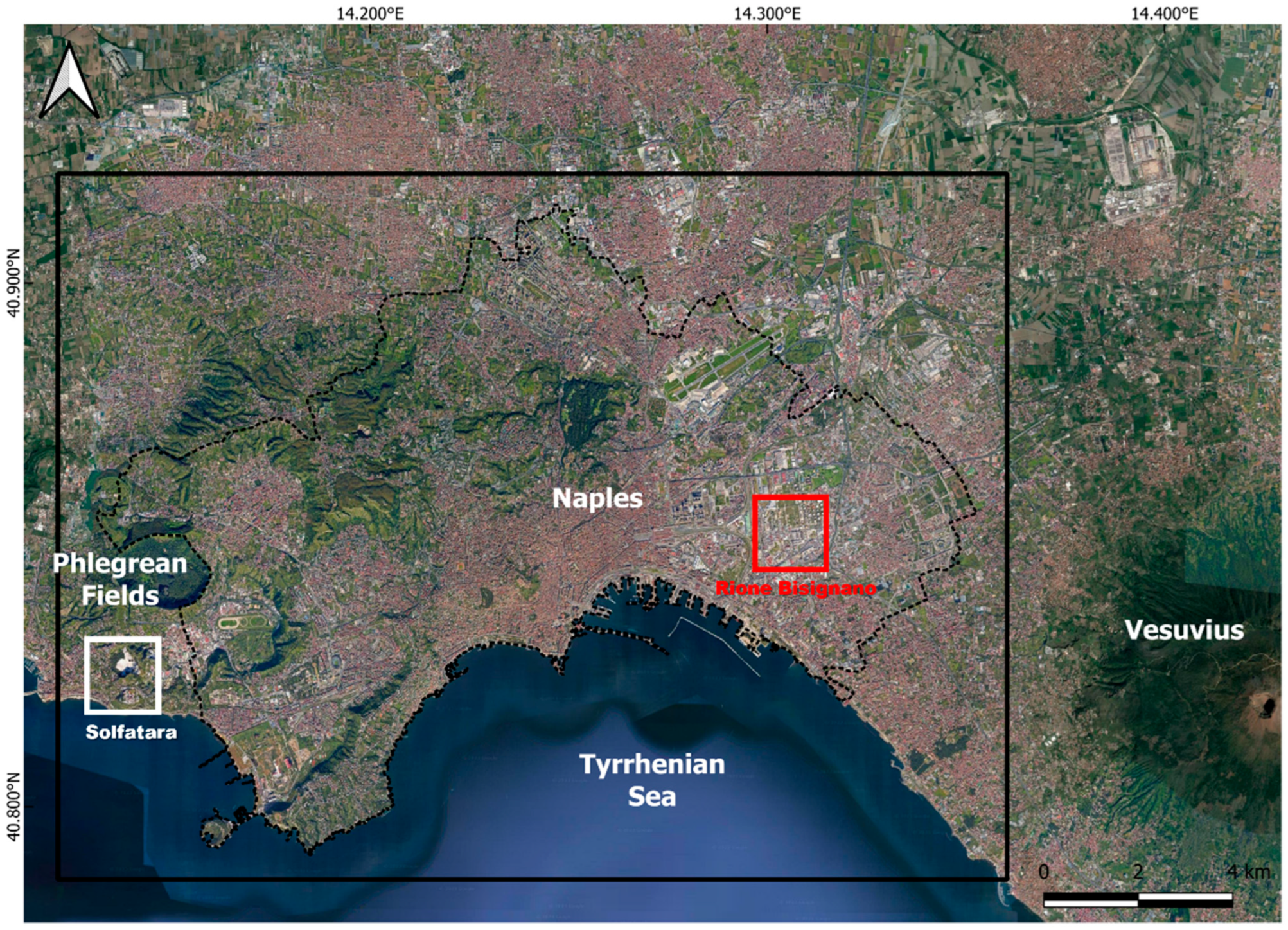
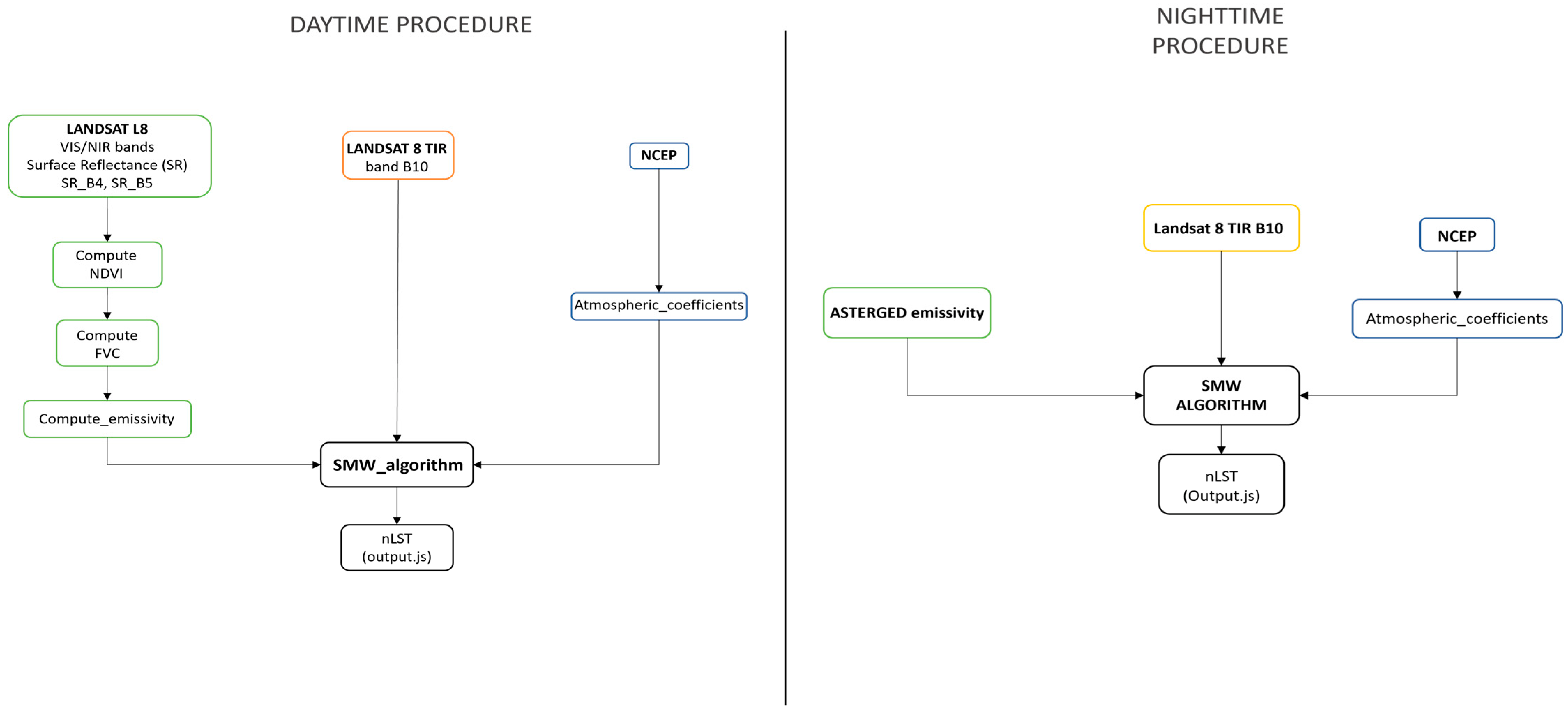
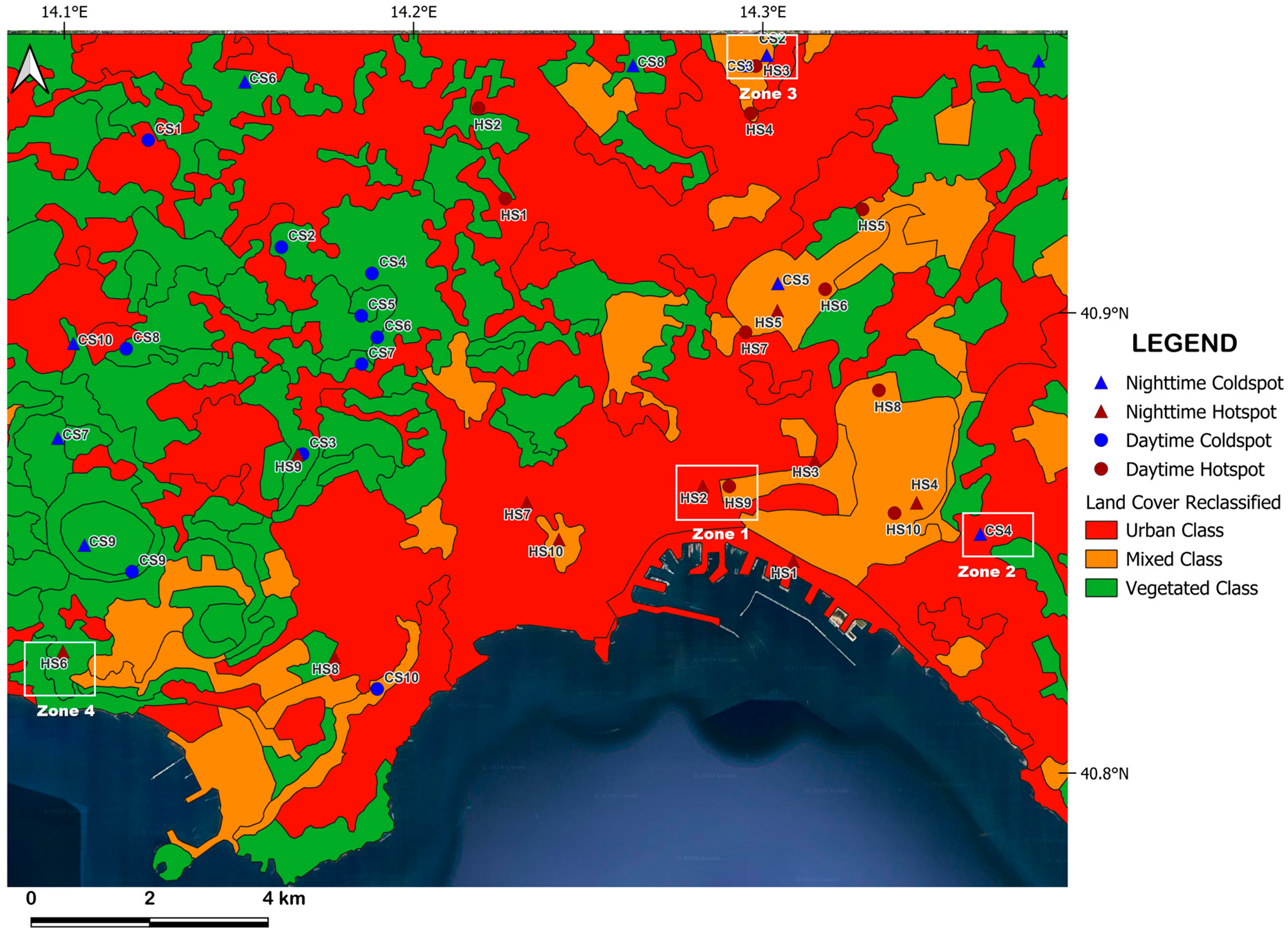
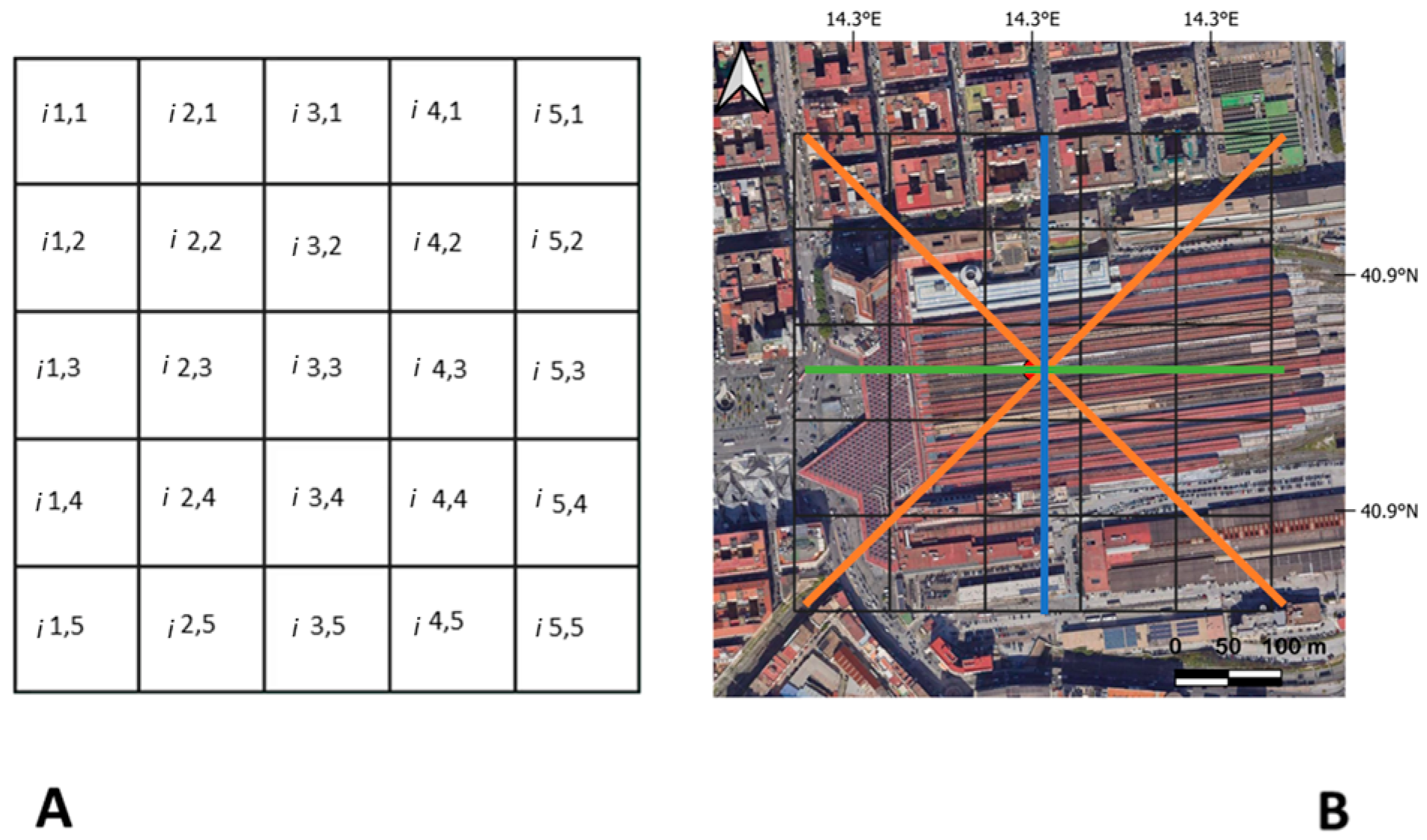
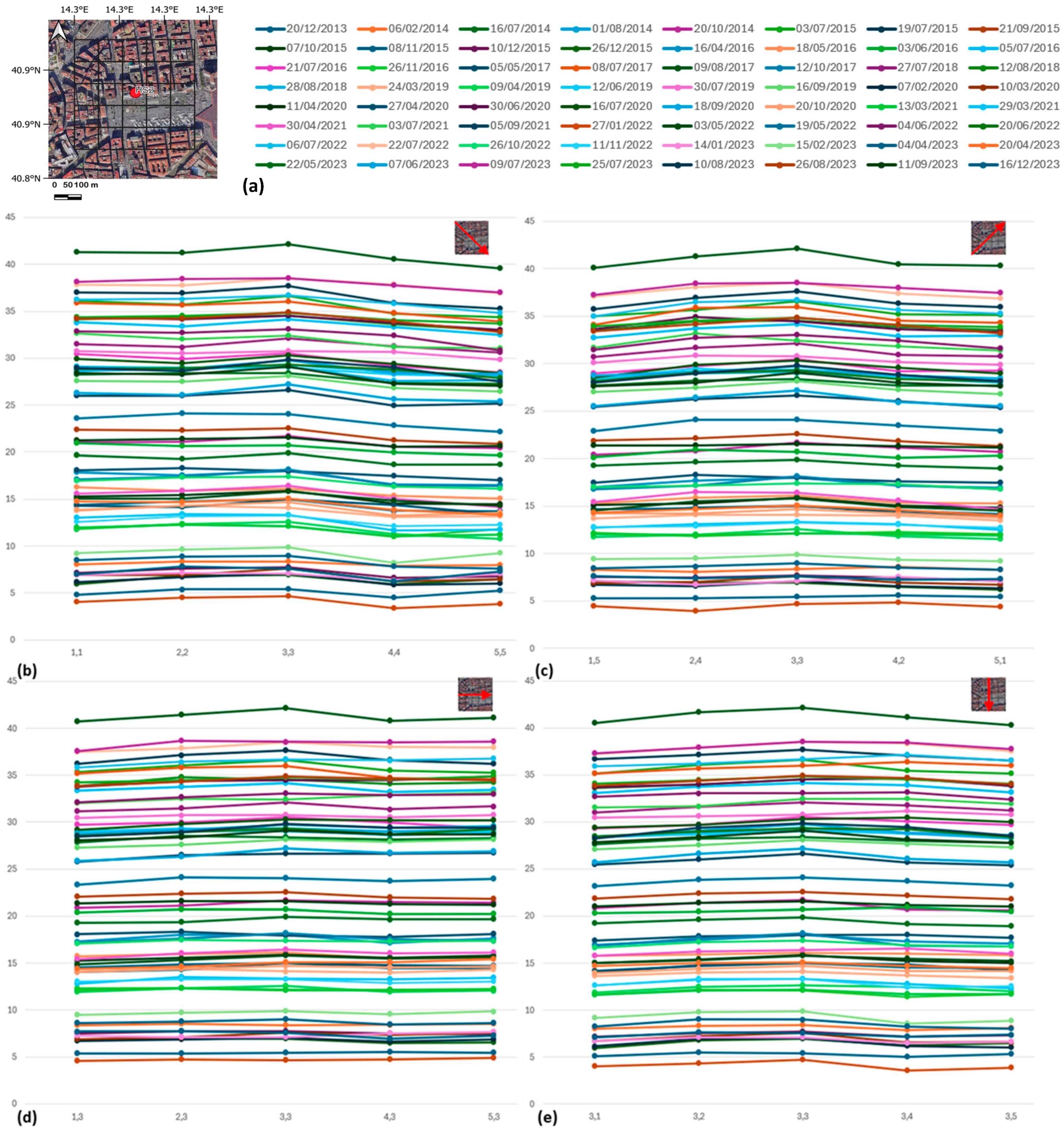
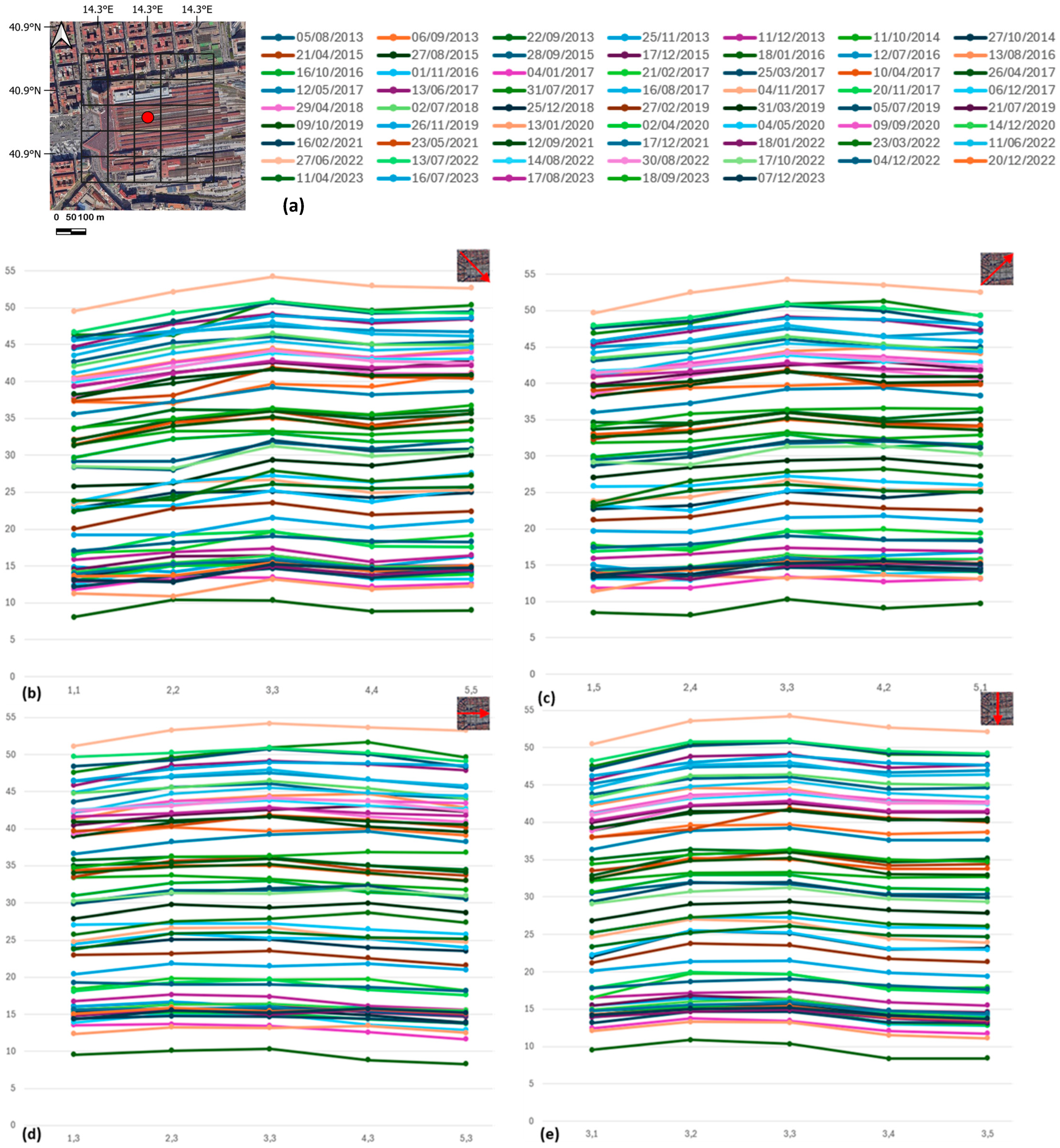
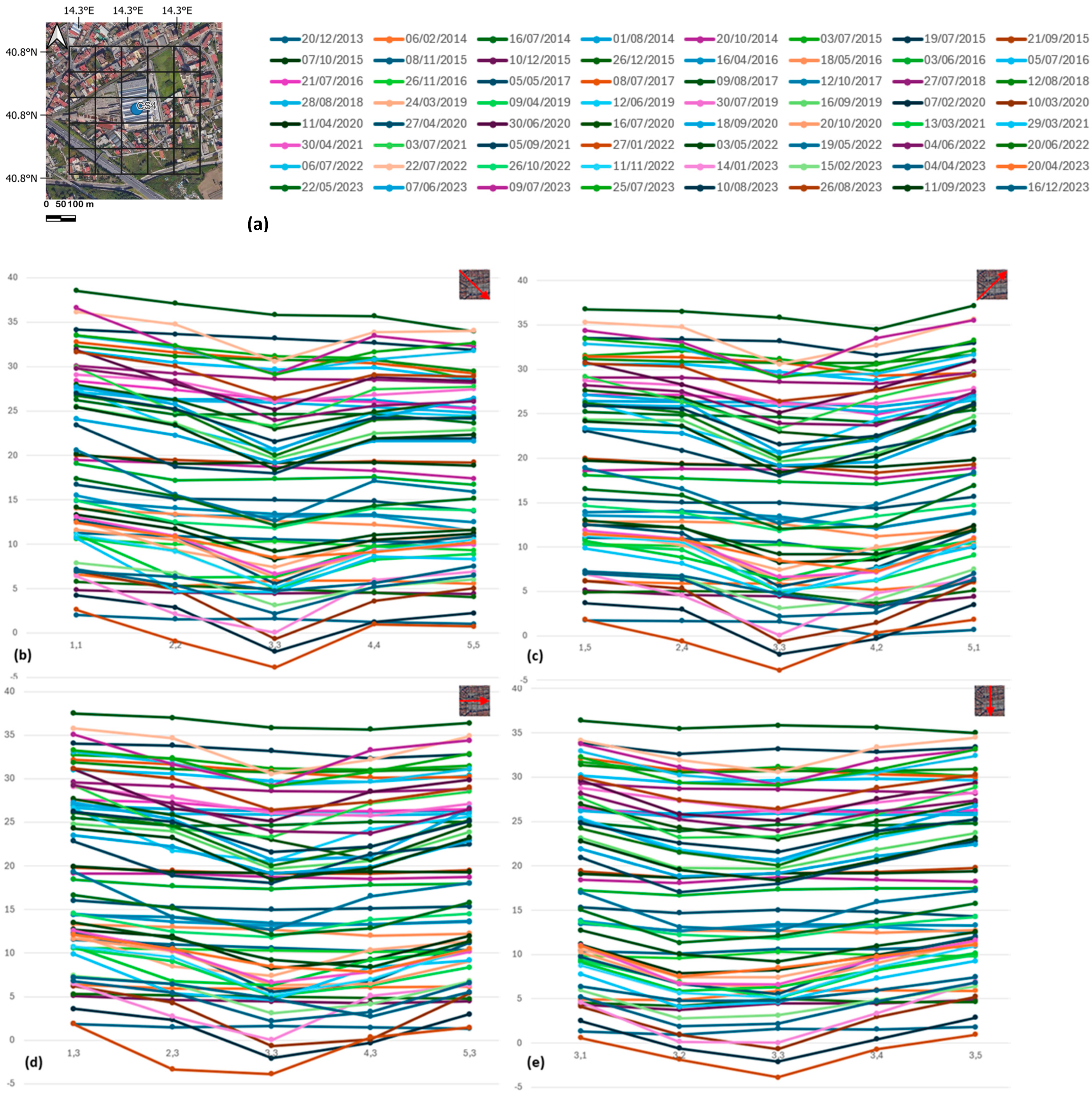
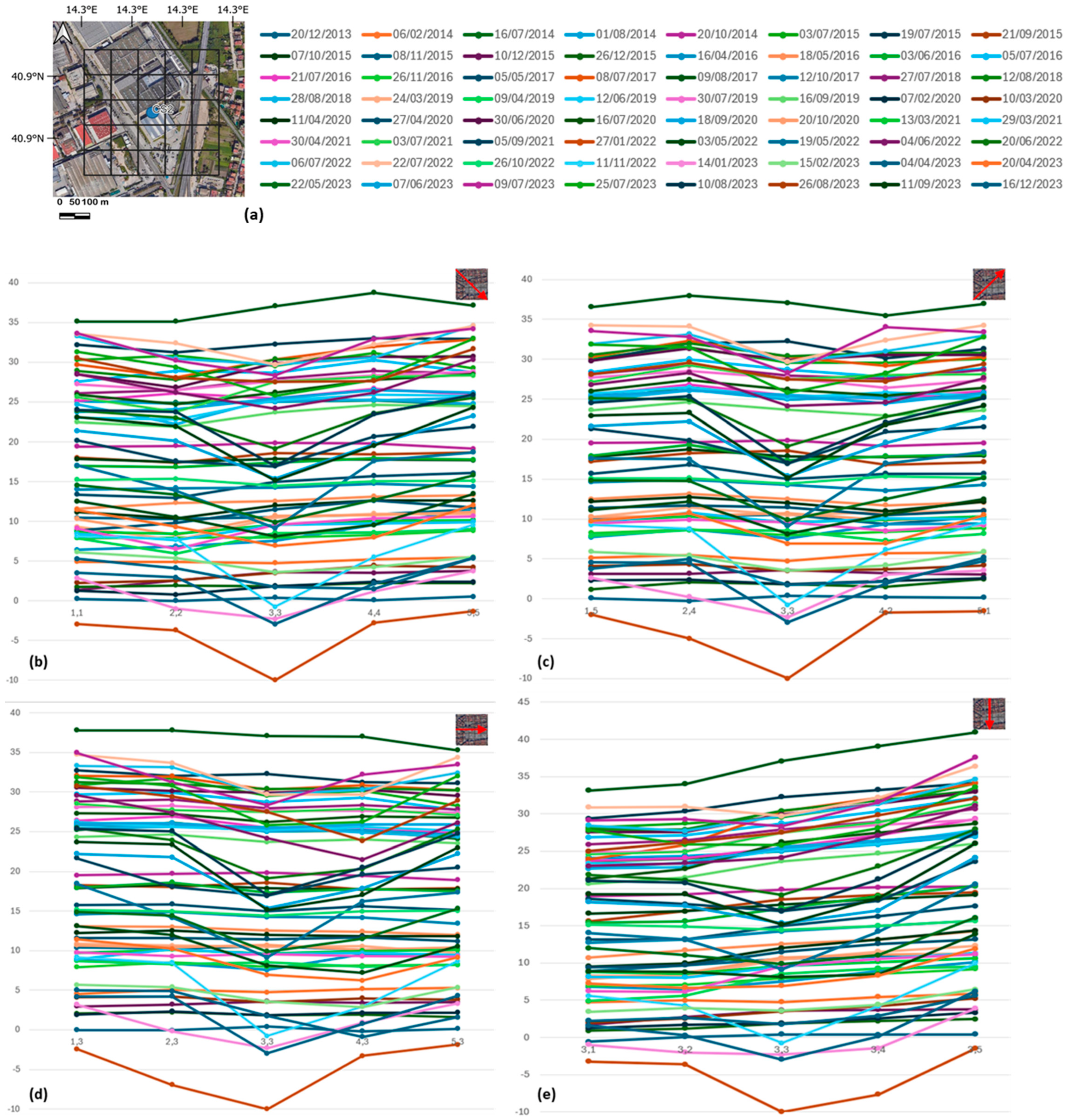
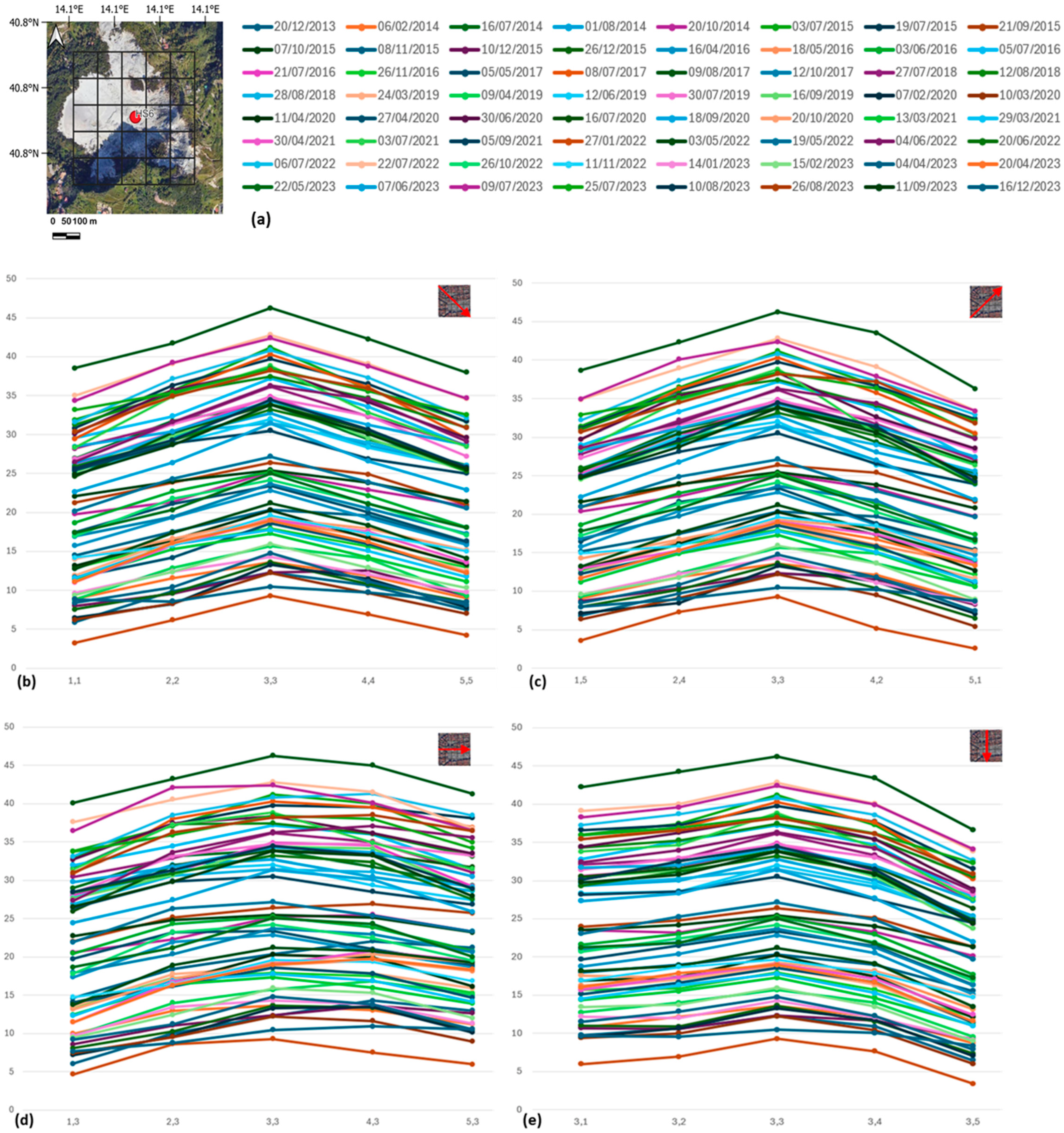
| Satellite | Bands | Wavelength (μm) | GEE Dataset | Equatorial Crossing Time |
|---|---|---|---|---|
| Landsat 8 (OLI, TIRS) | RED B4 | 0.64–0.67 | LANDSAT/LC08/C02/T1-L2 | 10:00 a.m. 16 days |
| NIR B5 | 0.85–0.88 | LANDSAT/LC08/C02/T1-L2 | ||
| TIR B10 | 10.06–11.19 | LANDSAT/LC08/C02/T1_TOA |
| Satellite | Bands | Wavelength (μm) | GEE Dataset | Equatorial Crossing Time |
|---|---|---|---|---|
| Landsat 8 (OLI, TIRS) | TIR B10 | 10.06–11.19 | LANDSAT/LC08/C02/T1_TOA | 10:00 a.m. 16 days |
| Terra (ASTER) | TIR B13 | 10.95–10.95 | NASA/ASTER_GED/AG100_003 |
Disclaimer/Publisher’s Note: The statements, opinions and data contained in all publications are solely those of the individual author(s) and contributor(s) and not of MDPI and/or the editor(s). MDPI and/or the editor(s) disclaim responsibility for any injury to people or property resulting from any ideas, methods, instructions or products referred to in the content. |
© 2024 by the authors. Licensee MDPI, Basel, Switzerland. This article is an open access article distributed under the terms and conditions of the Creative Commons Attribution (CC BY) license (https://creativecommons.org/licenses/by/4.0/).
Share and Cite
Scalabrini, A.; Musacchio, M.; Silvestri, M.; Rabuffi, F.; Buongiorno, M.F.; Salvini, F. Satellite Time-Series Analysis for Thermal Anomaly Detection in the Naples Urban Area, Italy. Atmosphere 2024, 15, 523. https://doi.org/10.3390/atmos15050523
Scalabrini A, Musacchio M, Silvestri M, Rabuffi F, Buongiorno MF, Salvini F. Satellite Time-Series Analysis for Thermal Anomaly Detection in the Naples Urban Area, Italy. Atmosphere. 2024; 15(5):523. https://doi.org/10.3390/atmos15050523
Chicago/Turabian StyleScalabrini, Alessia, Massimo Musacchio, Malvina Silvestri, Federico Rabuffi, Maria Fabrizia Buongiorno, and Francesco Salvini. 2024. "Satellite Time-Series Analysis for Thermal Anomaly Detection in the Naples Urban Area, Italy" Atmosphere 15, no. 5: 523. https://doi.org/10.3390/atmos15050523







